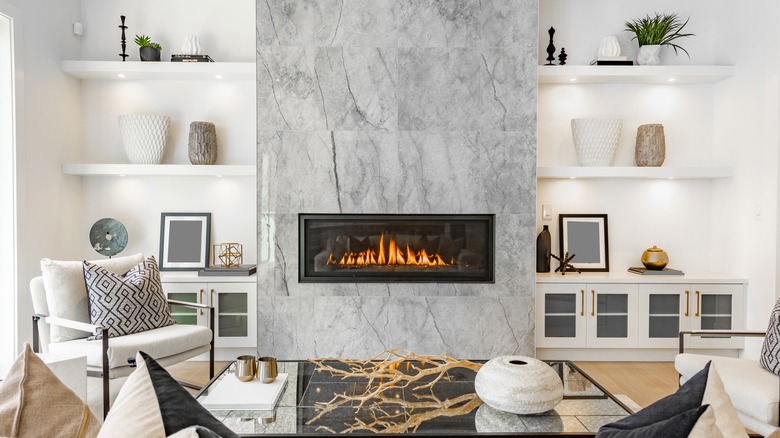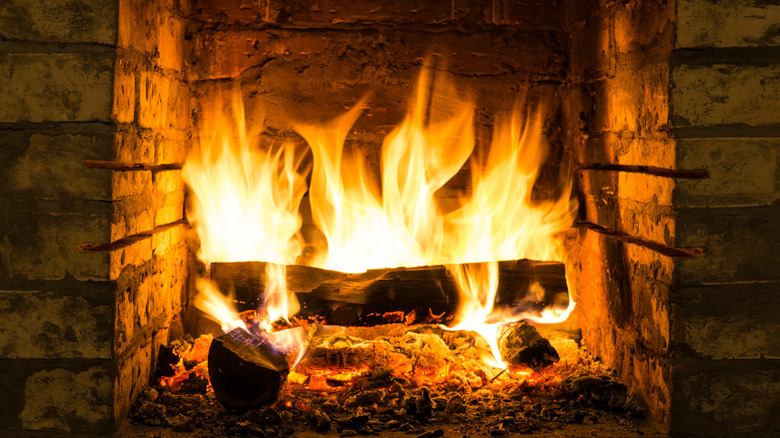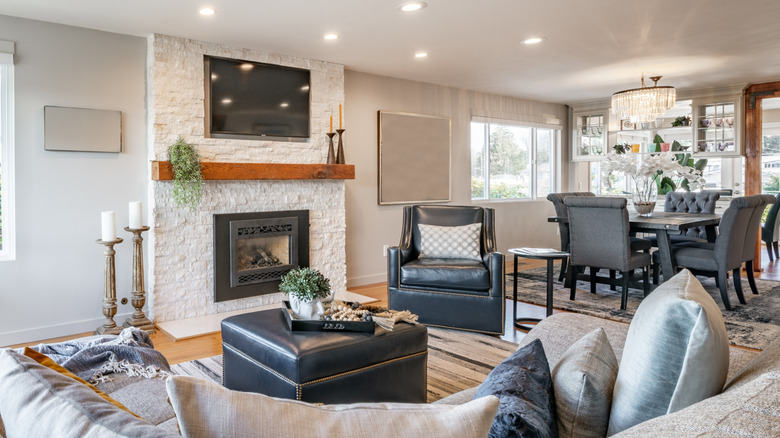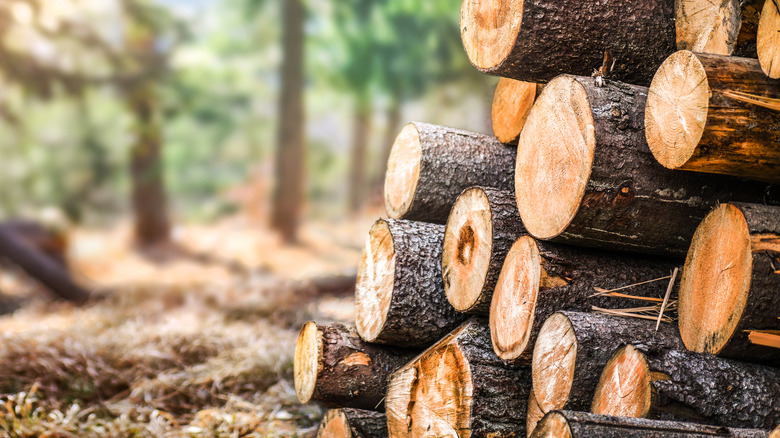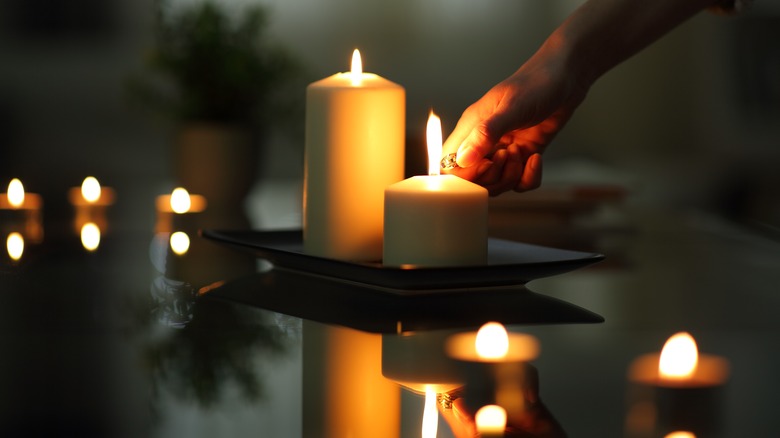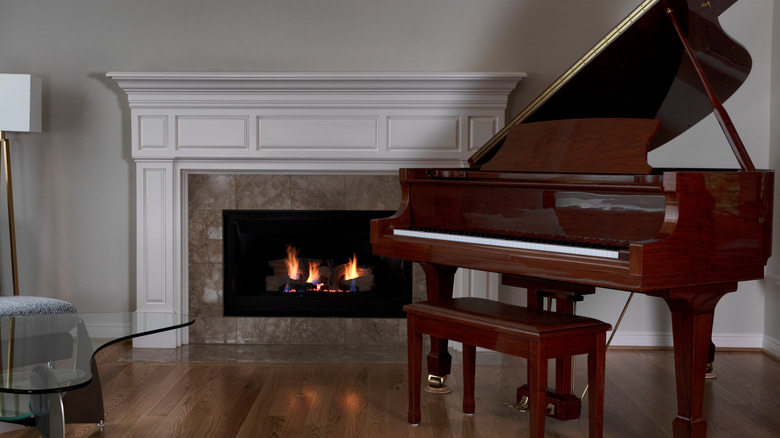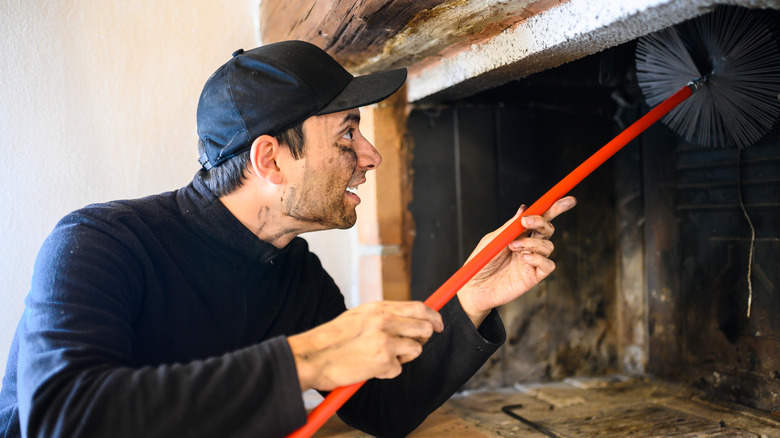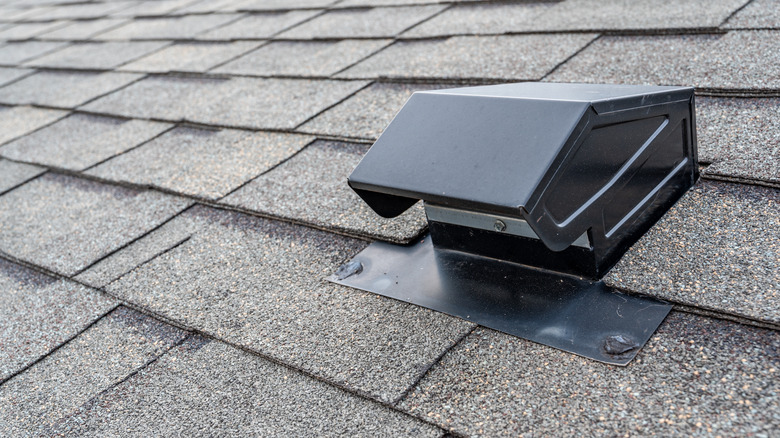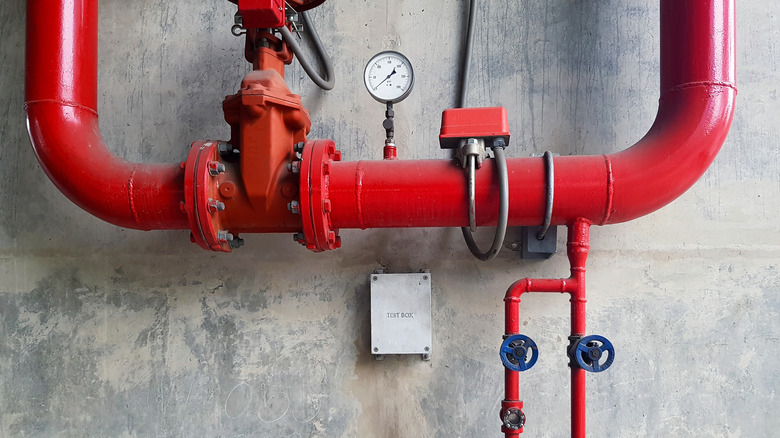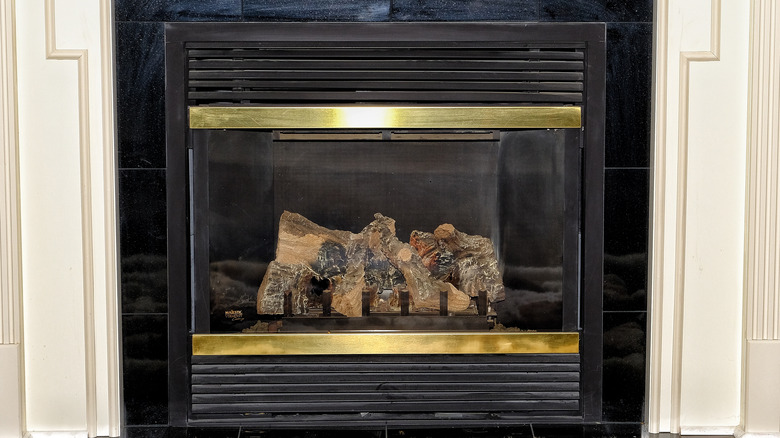The Hidden Downsides To Gas Fireplaces
Gas fireplaces are known to be more convenient and easier to operate than their traditional counterparts, but that doesn't mean they don't come without downsides. Fireplaces have been around for thousands of years. Since the 1100s, fireplaces evolved from what originated as fire pits when two-story buildings started developing. That led to the dawn of the chimney, and the rest was history!
It wasn't until the 1900s that fireplaces were recognized as architectural elements and less as the primary heat source within modern homes. At this point, they became all about ambiance and were less of a life necessity. Since both traditional and gas fireplaces are beloved in today's homes and the real estate world, it's a good idea to understand why you may or may not want to go for a gas fireplace in your own living space.
The differences between gas and traditional fireplaces
Before we get into the downsides of gas fireplaces that you may not know, let's talk about how they fundamentally differ from their traditional counterparts. Wood-burning fireplaces come in different forms, with open hearth fireplaces the most common. This type of fireplace boasts both pros and cons. First, they're more environmentally friendly than gas fireplaces since firewood is a more renewable resource than gas. They are also highly regarded because they don't rely on electricity, making them a great heat source if you lose electricity in your home.
Now let's get into the cons. First, natural fireplaces can cause drafts, which will drive your utility bills up. You also need to source and maintain a supply of firewood all winter long to use your fireplace. And you'll need to keep up with annual inspections of your fireplace hearth, or else certain dangers are possible. When burning wood, there are several pollutants and particles released into the air that could potentially affect your heart and lung health.
Next up is gas fireplaces. These fireplaces are known to burn more efficiently, and there are different types of gas fireplaces. First is a direct-vented, built-in fireplace. This type closely mimics a traditional, wood-burning fireplace and has to be vented through a chimney or a pipe. The other gas fireplace options are of the ventless, built-in variety. As the name suggests, it doesn't require a vent and creates a less traditional fireside ambiance, as the flame appears bluer.
The increased price of fuel
The fuel to run your gas fireplace doesn't come cheap. In 2015, the average cost per hour of operating a gas fireplace was 29 cents per hour. As of 2020, this hourly cost went up to 40 cents per hour. More than likely, that price is even higher given the soaring cost of current gas prices. Also, it's important to note that the cost of operating your particular fireplace varies by location. While a mere 29 to 40 cents doesn't seem like much, it'll add up as you run your gas fireplace nightly during winter.
A gas furnace is more efficient than most gas fireplaces. While they do, however, have a higher price tag than your artificial fireplace, they do a better job of heating your home in general. That's something to think about when considering your fireplace choice.
A lack of that wood aroma
Everyone loves the smell of a fire during the winter. Unfortunately, that's one thing you'll miss out on when you have a gas fireplace. You'll have to choose between the ease and simplicity of a fire with a button switch versus the ambiance that the scent of wood and crackling sounds are known to provide. Wood-burning fireplaces of all varieties feature the highly coveted cozy feeling we frequently see in pop culture or dream about on a snowy winter evening.
However, many homeowners are choosing the convenience of gas fireplaces. Not only can they turn it on with the press of a button, but there's no need to collect or source firewood. For many, the low maintenance of gas fireplaces is worth missing the smell of burning wood that so many lust after. However, the choice is for you to decide!
It might not run if there's a power outage
Power outages are an unfortunate fact of life. While some gas fireplaces will run during a power outage, others won't. Wood-burning fireplaces don't have this disadvantage, as they require zero electricity for operation. Many electric fireplaces can operate when the power goes out. Given their vertical pilot light, they can work with no electricity. In this case, you can safely light the fireplace with a regular lighter or match if the fireplace has outside vents. However, keep in mind that if you manually light your fireplace in a power outage, it will produce less warmth than in normal conditions.
On the other hand, some gas fireplaces have a different ignition system. When that's the case, they'll only run with a backup battery during a power outage, which may render your gas fireplace useless if you don't have one.
The upfront cost is higher
Wondering about the cost to put in a gas fireplace? It's not exactly cheap to install a gas fireplace in your home or backyard area. HomeAdvisor did the research and crunched the numbers to prove it. On average, installing a gas fireplace will cost you $4,000. However, the average cost ranges between $2,700 and $5,800. The price tag depends on different factors, including your location, fireplace surroundings, and the type of gas fireplace you choose. The price can go up or down depending on whether you need to add a new vent to accommodate the addition, especially if you're adding a fireplace from scratch or swapping out a different model.
While adding a gas fireplace can be affordable, costing as little as $600, it can run up to a whopping $10,000 for higher-end models or more complex installations. Keep this in mind if you're considering investing in a gas fireplace, and set your budget accordingly.
Certain safety risks exist
While it's easy to assume that an artificial fire doesn't present a fire hazard in your home, it's always good to be careful. Beyond that, there are other safety risks associated with these fireplaces. Failing to maintain or ventilate your gas fireplace can lead to incomplete combustion, prompting the creation of carbon monoxide. In some cases, carbon monoxide can even be fatal.
The best defense against this danger is to have your fireplace and vent regularly inspected. Clean your fireplace and vents for safety purposes. Additionally, every home with a gas fireplace should have a carbon monoxide detector. This detector will work double duty in your home, alerting you early to the presence of carbon monoxide and smoke in your home. Many of these detectors can even be hooked up to smart home technology, allowing you to monitor your home's safety from a distance.
Choosing a fireplace size could get tricky
Believe it or not, a fireplace that's too large can cause discomfort. You may also be surprised to learn just how many factors you need to consider when choosing the size of your gas fireplace. The ceiling height in your living space is something to consider. High ceilings can increase the volume of the room, which changes the fireplace's heating capacity. Another factor is insulation. Poor insulation causes a gas fireplace to have a lower heating capacity. On the other hand, if your home is well-insulated, it will enhance the heating capacity.
Something as simple as the number of windows in your home or the room can affect the efficacy of a gas fireplace. The more windows, the more cool air enters your home. An open floor plan may demand a large fireplace to heat the space. Finally, the presence of other vented appliances in the same room or area as your gas fireplace will have an effect. If other fixtures in the space use external venting, there may be more of a draft in the room, which diminishes the efficiency of the gas fireplace.
It can't run as long as a natural fire
Sitting in front of a blazing fire all day when it's cold outside or snow is falling may sound pretty nice. However, you may be saddened to learn that running your gas fireplace for too long can be dangerous. A gas fireplace typically can't burn as long as a wood-burning fire. Vertical Chimney Care notes that you shouldn't let a gas fireplace run for more than three hours. Leaving a gas fireplace on for too long can cause a gas leak, leading to a potentially deadly carbon monoxide production within your home.
The second potential consequence is a house fire. These are more common with unvented gas fireplaces or improperly sealed models. Chimney fires can happen when these fireplaces are left running for too long. Whether you have a gas or wood-burning fireplace, it's never a good idea to leave a fire burning overnight unattended, as that is a definite safety risk.
There's still maintenance required
Many people think a gas fireplace requires little to no maintenance. While there may be less care, you'll still need to keep up with this home feature. You can clean a gas fireplace as a DIY project. However, being around natural gas can be risky for those uncomfortable with it. For most homeowners, that means hiring a professional service once a year. It's best to clean the fireplace during the summer when it's not in regular use.
A professional will do several things to ensure your fireplace is in safe and tip-top working condition. For example, they'll inspect the exterior for cracks, check the glass, examine logs for wear and tear, check the gas ignition for lighting issues, look at carbon monoxide detectors, and finally — inspect the chimney. Additionally, they will vacuum the interior to rid it of dust, dead bugs, and debris.
There are concerns about venting
Getting a gas fireplace isn't always straightforward, as you need to learn about the different vent options from a safety standpoint. Some gas fireplaces mimic wood-burning fireplaces in their need to vent fumes via what's referred to as a flue. If you have a chimney, it's easy to install a flue.
However, it's trickier if a home doesn't have a fireplace. The undertaking and cost of installing one can be overwhelming. That's why some homeowners opt for a ventless gas fireplace. This type of fireplace emits fewer fumes, meaning the flue is unnecessary. Although ventless fireplaces are known to burn more efficiently, they're quite controversial, and are even banned in certain states due to concerns surrounding carbon monoxide poisoning, with nowhere for fumes to go if something goes wrong. Since the fireplace can't draw air from anywhere external, ventless fireplaces burn the oxygen in the room to function. While these models have built-in carbon monoxide detectors as a safeguard, they still raise concerns about potential safety risks.
There are operating costs
Besides the high cost of entry to install a gas fireplace, there are operating costs outside of paying for fuel. According to Regency Fireplace Products, a gas fireplace insert can cost between $580 and $1,160 annually. They estimate a gas fireplace to cost around $550 to $1,100 every year when used to supplement heating in a home utilizing natural gas. Finally, a freestanding gas stove runs between $1,000 to $2,000 yearly.
Of course, multiple factors affect the cost of operating a gas fireplace. The first is the size of your home, as heating a larger space will require more power and gas, and therefore cost more. Next, the height of your ceilings will also affect the efficiency of your fireplace, as will your home's insulation quality. Finally, the cost of gas will play a large part in the annual price tag. Your end cost will depend on your home, first and foremost.
You'll need a natural gas connection
You'll need to install a natural gas connection to operate your gas fireplace. It's not a run-of-the-mill, quick, or easy DIY project. It is a challenging task that will require specific materials, a great deal of time, and, most importantly, the appropriate expertise regarding gas lines. If you don't know how, you won't be able to complete this project safely.
Incorrectly installing a gas line could lead to serious issues down the line, such as a gas leak that can pose a fatal risk to you and your family. You have to be confident in your skills to install the gas line, or you need to hire a professional to complete the project to the correct standards. A gas connection is vital to attaining a gas fireplace, as it can't operate without a direct gas source.
The flame from a gas fireplace isn't as large or alluring
Many people dislike that the flame of a gas fireplace is commonly less alluring than a wood-burning fireplace. After all, that ambiance draws people toward a fireplace in the first place, in many cases. A lack of a large, roaring flame turns some homeowners off the idea of a gas fireplace, as it simply can't reach that same level as its wood-burning counterpart.
This is because the gas valve limits the size of the flame. Gas-powered flames tend to be smaller, which causes gas fireplace owners to seek ways to enlarge them in search of that "roaring" effect. While there are ways to enhance a gas fireplace flame — for instance, by checking and potentially adjusting the gas pressure at the fireplace switch — that doesn't mean it's an easy feat. Messing with the settings of a gas fireplace can pose a potential danger to your home and family. Any time you're dealing with natural gas, you need to be sensitive to the creation of carbon monoxide and act accordingly to mitigate what could be a fatal issue.
It can become outdated
Your gas fireplace may become outdated over time, unlike a traditional fireplace that will likely remain in style due to its classic nature. While gas fireplaces may seem like the hottest and newest technology, and you may elect to install the freshest model, it doesn't mean that they won't soon become outdated as gas fireplaces continue to evolve.
Polished brass was a popular look for gas fireplaces not so long ago. However, this is no longer in style in today's world. Those with a polished brass gas fireplace are now looking to either install a new model, which can be a costly venture, or find other ways to modernize this part of their home. One way to update your fireplace is to give it a fresh coat of paint. However, the idea of your gas fireplace going out of style when the next trend comes along is something to consider as you decide on what type of heating source to add to your home.
